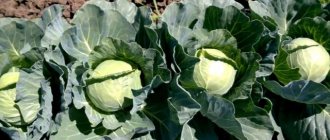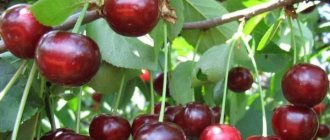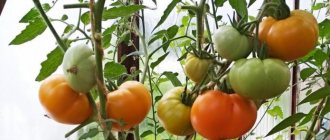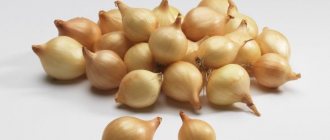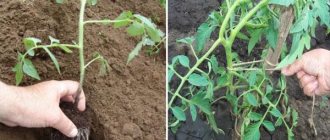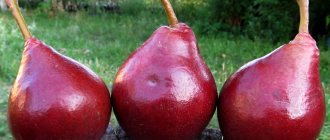The history of the appearance of radishes goes back to the Middle Ages, but Peter I brought them to Russia at the end of the 17th century. Today, radishes are an ingredient in many national dishes of France, Mexicans make original figurines and entire sculptures from it, but we Russians cannot imagine the main thing of summer dish - okroshka - without her participation.
This root vegetable is healthy, early ripening, easy to care for, which is why summer residents love it. The variety of tastes has given rise to a variety of varieties. The radish hybrid Sora f1 embodies the desires of all gardeners. Why is it so popular? Let’s look at it further.
Description of the Sora radish variety
The pulp is homogeneous, without voids inside
Radish Sora belongs to the group of early varieties, early ripening species. Root crops need 24-27 days to ripen. It was bred for all-season cultivation from spring to late autumn. The plant has low, compact tops, but developed, with a large number of leaves. The leaves have a typical radish shape and are light green in color.
Radishes are large and can weigh up to 35 grams. The shape is round, with thickened crops it is oblong, more oval. Sometimes you may find deformed root vegetables. The color is bright red, the spine is thin, of medium length, red on top, like radishes, and white below. The pulp is homogeneous, without voids inside. The taste is juicy, without pronounced bitterness, crispy when bitten.
Types and varieties of radishes
Radish varieties for open ground are divided according to ripening periods into super-early ripening, early ripening, mid-ripening and late ripening.
Ultra-early or early ripening varieties of radish
ripen in 18-20 days. The most famous of them:
- 18 days – the roots of this variety reach maturity during this period; they have juicy, tender pulp, a cylindrical shape, and a deep pink color;
- The firstborn is an ultra-early high-yielding hybrid that ripens in 16-18 days. Large, round dark red root vegetables of this variety are resistant to bolting and cracking, their flesh is sweet and juicy.
Early maturing varieties of radish
ripen in 20-30 days from the moment of emergence, the best of them include:
- Ilka - the yield of this variety is quite high, the root crops are scarlet in color, round, weighing from 15 to 25 g, dense, juicy, the flesh is white and white-pink, the taste is medium-sharp, without bitterness. The variety is resistant to low temperatures, bolting, formation of porosity or woody pulp;
- French Breakfast is also a popular productive variety with bolt-resistant long, cylindrical dark red fruits weighing up to 45 g with a rounded white tip. The pulp is juicy, without bitterness. Disadvantage: shoots in extreme heat;
- Saxa - this variety ripens in 23-27 days, the root shape is round, the color is bright red, the flesh is white, juicy, with a slightly pungent taste. The average weight of the root crop is 22 g. The variety is resistant to flowering and retains freshness for a long time;
- White fang - the conical root crops of this white variety, original for radishes, ripen in 33-40 days, reaching a length of 12 cm and gaining weight up to 60 g. The pulp is juicy, the taste is slightly pungent;
- Zhara is a high-yielding variety that ripens in three weeks. The root vegetables are small, dark red, round, weighing up to 25 g. The pulp is white or white-pink, the taste is slightly pungent. The variety, despite its name, does not like heat, so when grown in hot weather it should be covered with a canopy.
Mid-season radish
ripens in 30-35 days. The best varieties of this group are:
- Vera is a stem-resistant, productive variety with bright red root crops of almost the same size, resistant to cracking;
- Helios is a variety with yellow round root vegetables with juicy pulp of pleasant taste;
- Kvant is a productive variety that ripens in 30 days with pinkish-crimson root crops of delicate taste. When stored, retains elasticity for a long time;
- Zlata - ripens in a maximum of 35 days from the moment of germination. A yellow round root vegetable with dense, tender and juicy pulp reaches a weight of 18 g;
- Duro is one of the most popular and productive varieties with very large (up to 10 cm in diameter), round red root vegetables weighing up to 40 g, which requires more spacious planting in rows: the distance between specimens should be at least 10 cm. The variety is resistant to stemming , woodiness and cracking of fruits, is well stored.
For late-ripening radish varieties
which require 36-45 days to ripen include:
- Red giant is a productive variety with large cylindrical bright red fruits up to 14 cm long with juicy white-pink pulp and a slightly pungent taste. Resistant to cruciferous flea beetle and mole cricket, it is perfectly stored: in a container with sand it can be kept fresh for up to 4 months;
- Ice Icicle - a variety almost identical to the Red Giant, but only with white root vegetables;
- Champion - this high-yielding variety ripens in 40 days. Its root vegetables are crimson-red, large, elongated and round, weighing up to 20 g, the pulp is juicy, tender, but dense, pinkish-white in color, the taste is good. Root vegetables do not form voids and do not become flabby and soft for a long time;
- Dungan - the root crops of this cold-resistant variety have an elongated shape, up to 15 cm long, reaching a weight of 45 to 80 g. The pulp is juicy, white, and the taste is excellent;
- Würzburg-59 – a variety with large, rounded raspberry root vegetables with dense, juicy pulp that retains its elasticity for a long time;
- Rampoush – the ripening period of this variety is 35-45 days. Its roots are elongated, spindle-shaped, the peel, like the pulp, is white. The taste is medium spicy, without bitterness. The variety is resistant to bolting.
Late-ripening varieties are usually sown in the first ten days of August.
Rhubarb: growing from seeds, planting and careRadish: growing from seeds in the garden
After this article they usually read
Add a comment
Growing Sora radish
The purchased radish seeds are already ready for sowing. They do not need disinfection, since the manufacturer carries out this procedure independently, additionally saturating the seed with nutrients.
Since the crop is resistant to low temperatures, it is sown in the greenhouse from the beginning of spring. Experienced farmers sow grains several times a season, until mid-autumn.
The soil for radishes is light and fertile with neutral acidity. Litmus paper will help determine its level. A little earth is dissolved in a glass of water and the indicator is lowered into it.
If its color changes to red, then the permissible level of acidity in the soil is exceeded and dolomite flour or slaked lime should be added to it. If the color of the indicator remains unchanged, then the acidity in the soil is not exceeded.
Reference. Dolomite flour, unlike slaked lime, begins to act later, but it is safer for the environment.
Landing
The seed material is buried 1-1.5 cm, but not deeper than 2 cm, otherwise the fruits will not have a round, but an elongated shape.
It is not recommended to apply fertilizers to the soil before sowing; it is better to do this long before planting. To ensure soil fertility, it is saturated with peat or humus.
Planted in two ways: strip and continuous. In the first case, two rows are made, the distance between which is 5 cm. The distance between the holes is 4-5 cm. The next tape (that is, two more rows) is placed at a distance of 15 cm. With this method of sowing, it is convenient to weed the beds.
The continuous sowing pattern is 5x5 cm. One grain is placed in each hole, since the germination rate of Sora radish is high, almost 100%. With frequent sowing, the plantings may become denser, which will lead to a decrease in yield.
After sowing, moisten the soil and wait for seedlings to emerge. Typically, grains germinate on the fifth day, but cold or, conversely, hot weather can delay germination by several days.
Care
When caring for a variety from the cruciferous family, it is important to maintain an even level of humidity. Over-wetting the beds will lead to cracking of the fruits. Lack of moisture will also have a negative impact.
After watering, the soil is loosened to improve air permeability and protect the beds from the invasion of ground pests.
The crop does not need fertilizing due to the short growing season. It is quite enough for the fertilizers that were applied before sowing. The crop will give a good harvest in the soil where a full complex of mineral fertilizers has been added, with a predominant content of phosphorus and potassium, and humus.
Reference. Organic fertilizers are not used when growing radishes.
Disease and pest control
If crop rotation rules are not followed, the likelihood of crop disease increases. This is due to a lack of nutrients that are necessary for full development and healthy immunity . One of these diseases is clubroot. It is characterized by swelling on the roots, as a result of which the plant withers and dies.
Clubroot is not easy to control, so it is important to protect radishes from this disease. To do this, they weed the beds and do not plant seeds where plants from the cruciferous family previously grew. Three days before sowing, a little wood ash is added to the holes as a preventive measure.
Among the pests, cruciferous flea beetles cause irreparable damage to plantings. They are dangerous in the first two weeks after emergence. These are small black jumping beetles. They eat young leaves by gnawing holes in them. That is why it is important to protect plantings after germination.
Any non-woven material that freely allows air and light to pass through will do. Cruciferous flea beetles are also afraid of the smell of garlic, dill, marigolds and calendula. Planted fragrant herbs next to the radishes will reliably protect the beds from the invasion of uninvited guests.
Harvesting and application
Three weeks after germination, harvesting begins. The root crop ripens together, the fruits are almost the same size and even.
Large quantities of radishes are stored in wooden boxes with air holes . To prevent the fruits from touching each other, a sheet of cardboard is placed between the layers. The room temperature should be no more than +6°C. In such conditions, vegetables retain their taste and shape for a month.
The fruits tolerate transportation well. In the kitchen, the root vegetable is suitable for fresh salads, combines harmoniously with other vegetables, and serves as a decoration for main courses.
The best Dutch hybrids
Radish "Sora" is not a new variety, but has already become a favorite among many summer residents. It has many obvious advantages:
- He's early. You can sow it without waiting for the soil in the garden to warm up. On the contrary, it is recommended to plant the seeds as soon as the snow melts. Melt water will only contribute to its growth.
- He is precocious. You will be able to crunch on juicy radishes within three weeks after germination.
- It has excellent taste and shape. The fruits are round and quite large - 4–5 centimeters in diameter, bright red in color.
- Doesn't shoot. It is convenient to use in the summer months, since during long daylight hours it, unlike other hybrids, does not release arrows.
Such radishes are often used on an industrial scale, as they are well stored in a cool place, have no voids inside, and grow in the same shape and size. Another of its main advantages is that it is less susceptible to cruciferous diseases, such as downy mildew and mucous bacteriosis.
That is, if you value harvest throughout the season, as well as large root crops that are not susceptible to disease, then radishes are an excellent choice.
The Celeste F1 hybrid was also developed by the Dutch. It is not so early, rather mid-season, but it is very popular among farmers due to its high yield.
The yield of the Celeste variety reaches 3–3.5 kilograms per square meter of land.
The advantages of this hybrid are almost the same as those of Sora:
- ripens in 20–25 days;
- high and high-quality harvest: spherical smooth red fruits measuring up to 5 cm in diameter and weighing 25–30 g;
- excellent taste, juicy, slightly spicy white pulp;
- It is stored for a long time and transports well.
If there is too much harvest, the fruits can be placed in wooden boxes, sprinkled with sawdust or sand, and stored in the basement. This way you can store the radishes for another couple of months. The main thing is not to freeze the fruits, because then they will become fibrous and dry.
Dutch hybrid Cherriet F1 is the earliest ripening variety available. It will delight you with its crispy fruits in 16–18 days. And it is easy to plant, since the seeds of this radish do not require additional processing or soaking; they can be planted directly into the ground.
In addition to advantages similar to the Sora and Celeste varieties, it also has its own characteristics:
- Compact leaf socket. This allows radishes to be planted more densely, thereby saving space.
- Large fruits. With proper care, the fruits reach 6 centimeters in diameter and weigh 45 grams.
- Long-term storage. In the refrigerator it can retain all its properties for a month.
Cherryat is also good because even when overripe, it retains medium pungency and does not become very bitter, like most other types.
Since the variety is early ripening, you should be careful with chemical fertilizers. It is better to completely abandon their use, otherwise they will accumulate in root vegetables and affect your health.
The hybrid variety Rondar is a mid-season variety that ripens in 25–28 days. Its fruits are small, about 3 cm in diameter, but all are equally smooth and bright red. The fruits ripen synchronously, which distinguishes this hybrid from the rest.
Its tops also grow compactly, so planting can be done densely. Its yield is high, the fruits are juicy and dense, moderately spicy.
What kind of radish is this
Radish Sora f1 is a Dutch crop created at the end of the twentieth century. Since 2001, the hybrid began to successfully take root in Russia and entered the state register of breeding achievements. Recommended for cultivation in greenhouse conditions and open ground.
Reference. F1 hybrids are crops obtained artificially as a result of crossing different varieties. Their main difference from pure varieties is that the seeds from the harvest are not suitable for subsequent plantings.
Characteristics and description of the hybrid
Radish Sora is an early ripening plant, 23-26 days pass from emergence to full ripening. Not afraid of cold weather. The leaves grow straight, forming a compact bush.
Productivity is high, from 1 sq. m harvest 1.5-1.8 kg of fruit. The crop is planted from early spring to late autumn, which makes it possible to collect several full harvests per season.
Cinnamon with honey for weight loss: recipes, tips on how to prepare and use cinnamon and honey while losing weight (120 photos)
The plant is resistant to cruciferous (cabbage) diseases such as downy mildew and powdery mildew. Also, seedlings are not afraid of attacks from many insects.
Radishes are grown not only for personal use, but also on an industrial scale.
Description of fruits
The average weight of one radish is 15-20 g, but with good care it gains weight up to 30 g. The shape is round, the color is bright scarlet. The taste is slightly spicy - a piquant addition to bland vegetables. The pulp is juicy, without voids.
The ability to retain its presentation and taste for a long time allows the hybrid to be bred on an industrial scale for trade.
The photo shows the Sora radish.
Detailed characteristics and description of the variety
Appearance
The radish fruits of the described variety reach 4-5 centimeters in diameter . A distinctive feature of root vegetables is their lack of tendency to form voids.
According to agronomists, the radish pulp is quite juicy and tender. The taste characteristics of Sora are high. The tops are not very lush, low and sparse.
The shape of the root crops is even, regular, round, almost all fruits grow without flaws. The radish itself has a deep pink hue. The peel is very thin.
Let's see what Sora radish looks like:
Sowing time
Radish Sora can be sown in greenhouses from the beginning of spring. It is recommended to carry out several sowings per season with an interval of 15 days. Resistance to frost allows you to plant the root crop even in mid-autumn - slight cold will not harm the fruits.
Average weight
If you provide the root crops with proper and complete care, then a fully ripe radish will weigh approximately 30-37 grams.
Productivity per 1 hectare
It is worth saying that here, too, all indicators depend on the rules of care and cultivation. But agronomists claim that about 175 centners can be harvested from one hectare.
Where is it recommended to grow?
Radish Sora is a hybrid variety. Therefore, during the selection process, botanists worked on the versatility of the variety. This suggests that radishes are perfect for growing in greenhouse conditions, in open ground and even indoors.
It is worth noting that the yield will be much lower when planting seeds at home. This is normal, since in this case the radish does not receive all the elements it needs.
Resistance to diseases and pests
Hybrid varieties often show excellent performance in terms of immunity to diseases and pest attacks. The Sora variety is no exception, so many ailments are not scary for it. In addition, those diseases that do overcome radishes can be easily defeated.
Ripening period
The finished crop can be harvested within three weeks. It is worth noting that you need to count 21 days not from the moment of planting, but from the moment the first shoots emerge.
What types of soil does it prefer?
The soil for planting Sora radish should be light and fertile. The acidity of the soil should be neutral or weak. To reduce the acidity level, you need to add a little lime to the substrate. The most suitable type of soil is sandy loam or peat bogs. In autumn and spring, it is necessary to dilute the soil with humus.
Advantages and disadvantages of the variety
Due to the fact that Sora radishes can be grown from spring to late autumn, several full harvests can be collected in a year, but it is not only this quality that the variety attracts attention to.
Productivity with good care is up to 2 kg per square meter of plantings
- Seed germination is 80-90%.
- The Sora radish variety is unpretentious in cultivation.
- Root crops grow large, approximately the same size, and are of commercial quality.
- The variety can tolerate low and high temperatures during growth and is grown even in shaded areas.
- Keeping quality is excellent. Sora is popular among traders because it does not lose its commercial qualities during transportation and long-term storage.
- It usually does not release the arrow even when overripe.
- Plants of this variety rarely get sick.
- Productivity with good care is up to 2 kg per square meter of planting.
As for the shortcomings, a lot also depends on the place of planting and care.
- If there are a lot of pests on the site, then the Sora radish will most likely be affected by them, so timely treatment of the soil, seeds and possibly even the plants themselves during the initial period of development is necessary.
- Without thinning, the root crops will be small.
- Overwatering or underwatering can cause radishes to rot or taste dry and bland.
- When grown in summer, the Sora radish variety must be darkened, otherwise it may shoot out.
Care and harvesting
We recommend reading our other articles
- Horse colors
- Feeding cabbage seedlings
- Breed Muscovy duck (Indoutka)
- Garlic variety Gribovsky
The Sora radish variety does not require watering often.
The Sora variety is distinguished by its unpretentiousness. Basic maintenance procedures include thinning and removal of weeds. Thinning is done 2-3 times during the growing period so that the root crops can fully develop. The first time the crops are thinned is after a couple of leaves appear. Leave 2-3 cm of free space between neighboring plants, and when the plants grow larger, you need to thin out again, leaving 3-5 cm of free space.
As for weeds, even while preparing the land for sowing seeds, you need to carefully remove all weeds from it along with the roots. Then, as the crop grows, any weeds that appear are uprooted and burned off-site.
Important!
When sowing radishes early, it is worth covering the bed with agrofibre to get early shoots. After all, frosts are possible in early spring, and especially at night.
The Sora radish variety does not require watering often. An abundance of moisture is more likely to cause harm, so when growing in spring, you can water only during drought. But in summer and autumn, when the soil is dry, you need to organize regular but infrequent watering of the beds so that the root crops grow juicy. From time to time, the beds are carefully weeded, fluffing up the soil so that enough oxygen reaches the root crops. And thanks to the low tops of this variety, weeding is very easy - while working with a hoe, the roots or leaves are not damaged.
Rules for sowing and care
“Sora” can be grown after any crop, except for its close relatives - radish and cabbage and, in fact, radishes. She loves nutritious, breathable, non-acidic soil. For spring cultivation, the bed is prepared in the fall. After harvesting the previous crop, it is freed from weeds, thoroughly dug up, fertilized, and, if necessary, the acidity and structure of the soil is adjusted. If the soil is acidified, you need to add lime or dolomite flour.
Sand, peat, and wood ash are added to soil that is too heavy or dense. It is not advisable to fertilize with fresh manure even in the fall; it is better to scatter rotted manure or compost, superphosphate and potassium fertilizers over the garden bed before digging; digging will evenly distribute the fertilizers and move them to the desired soil horizon.
In the spring, as soon as the ground thaws, while it is still saturated with a large amount of melt water, the seeds are placed in prepared grooves to a depth of no more than 2 cm. It is advisable to place the plants at a distance of 3–5 cm from each other, and leave 10 cm between rows. If you buy seeds are from a breeding and seed production company, then they do not need to be soaked before sowing, they are already prepared for planting by the manufacturer.
The best crops will grow in the spring, while the days are not too long and the air and soil are full of moisture. If you sow in March, it is better to cover it with film or non-woven fabric; it is good when the film is stretched over the arcs. A cold-resistant variety will not die from the cold, but it will grow better and faster in the warmth.
With dense sowing, you will have to thin out the seedlings, and radishes do not really like transplanting at such a tender age, and the disturbed plants will be slightly delayed in development. Therefore, it will be better and more economical to immediately sow the seeds at the required distance from each other.
10 days after the emergence of seedlings, they can be fed with a solution of mullein infusion or chicken droppings; later this is not necessary. If the soil is not very fertile or it has not been fertilized in advance, then at 10 days of age you can feed it with nitrogen, and later, along with watering, give the plants phosphorus and potassium by dissolving mineral fertilizers in water. If the soil is fertile enough, then you can do without additional fertilizing.
All care for Sora comes down to weeding and loosening the soil; if it is very dry and hot, then you need to water it. As a rule, spring plantings have enough moisture. Radishes planted at the end of May or in the summer will have to be watered. And it is easy to loosen and weed these radishes, since they have small compact rosettes of leaves.
Diseases do not threaten her, but the cruciferous flea beetle may well deprive the owners of the harvest. To prevent this from happening, you need to treat the radishes with a mixture of tobacco dust and wood ash crushed to the same state. You need to powder several times with a break of 3-4 days.
Sowing radish variety Sora
In open ground, Sora radish develops quickly and produces an early harvest.
In open ground and in greenhouses, Sora radish develops quickly and produces an early harvest. Growing it is a pleasure, as many gardeners note. It grows easily in almost any soil, as long as it is not acidic.
Radishes should not be planted after cruciferous crops, which include cabbage, radish and lettuce. In the fall, the site is fertilized with phosphorus-potassium fertilizers to increase nutritional value, and then in the spring you can begin to sow seeds.
Interesting!
To prolong the fruiting of radishes, you need to sow them several times with an interval of 1.5-2 weeks.
Sowing can begin immediately after the snow melts, however, it is advisable to warm the ground in advance so that the seeds are comfortable. If it is not possible to plant in the spring, you can sow at any other time throughout the warm season. Seeds are usually sown using the belt method in several rows with a row spacing of 10-15 cm. The seed placement depth is 2-3 cm. You can sow in single file, but then you will need to thin out frequently or place the seeds at a distance of 2-3 cm from each other, then you will only need only 1 thinning.
Planting dates and scheme
For sowing and growing radishes of the Sora variety, it is recommended to allocate an area that is cleared of snow as early as possible. The site should be represented by light and highly fertile soil. The best predecessor crops for the Sora radish can be almost any vegetable crop that does not belong to the Cruciferous family.
Before sowing, basic fertilizers are applied to the soil on the site, and if necessary, preliminary liming of the soil is carried out in order to reduce acidity. The soil for cultivating radishes cannot be fertilized with fresh manure. It is recommended to sow radishes of this variety at several times, with an interval of two weeks between plantings. Seed material should be sown in a row with row spacing of at least 10−12 cm. The standard distance between radish seeds should be 2−3 cm with a sowing depth of 1−1.5 cm.
History and characteristics
Radish is a biennial plant belonging to the Brassica family. The culture comes from a related species - radish; it was bred in the Mediterranean about 5 thousand years ago.
Selection
The Sora variety was bred by Dutch breeders from the Nunhems BV company in the late 90s of the last century. In 2000, the Sora radish was included in the state register of Russia, which is permission to grow the crop throughout the country.
Description of the variety
The plant has a rosette of leaves of medium density. The leaf blades are oblong in shape and their color is green. The fruits are spherical, and can also be elongated or oval if there is not enough space for them when growing. The average weight of radishes is 35 g, diameter is 5 cm. The peel is thin and dark pink in color. The pulp is white, dense structure, not prone to the formation of voids. The taste is sharp, pleasant, without unnecessary bitterness.
Advantages and disadvantages
- Among the positive qualities of the variety are:
- planting the plant in open ground can be done after the snow has melted;
- precociousness of the crop;
- not prone to shooting;
- long shelf life;
- the ability to collect fruits several times a season.
- The disadvantages include:
- low immunity to pest invasion;
- the need to thin out seedlings.
Description
Radish Sora was bred by Dutch breeders at the end of the last century. The variety appeared in Russia in 2001, after which it was included in the State Register of the country.
This is an early ripening vegetable, ripening within 20-25 days after the sprouts appear. If you increase the time to a month, you get larger root vegetables.
Feature - there are no voids in the radishes; overgrown fruits retain their delicate structure and juiciness. It can be grown under any conditions - on a windowsill, in a vegetable garden, in a greenhouse; it easily tolerates cold, which is why it is sown in early spring.
Soil requirements:
- acidity – neutral or weak;
- structure – light, fertile;
- soil type – peat, sandy loam;
- The minimum temperature for planting is 0 degrees.
Planting dates depending on the region (spring, winter):
- southern latitudes: mid-March – early April, November;
- middle zone: mid-late April, October;
- northern regions: late May – early June, September.
Appearance
What Sora radish looks like:
- fruit diameter – 3-5 cm;
- weight – 20-40 g;
- pulp – tender, juicy;
- type of tops – sparse, low, spreading;
- fruit shape – perfectly round, even;
- radish color – rich pink;
- the peel is thin.
Advantages and disadvantages
Hybrid Sora has a significant number of advantages :
- high level of germination – up to 85-90%;
- resistance to unfavorable climatic conditions, cold;
- keeping quality and marketability – 97-98%;
- transportability (the variety can be transported over long distances);
- excellent yield;
- absence of arrows when overripe;
- storage duration;
- speed of maturation;
- increased immunity to pests and diseases;
- possibility of cultivation all year round;
- grows in the shade and under sunlight.
Flaws:
- the need for thinning (otherwise the root crops will be small);
- intolerance to excessive watering, which causes the vegetable to rot and spoil the taste and structure.
Productivity and areas of application
If you strictly adhere to the rules of care, then from 1 hectare you can get 70-75 centners, from 1 sq. m – 2-3 kg of fruits.
Radish Sora is used for internal consumption - preparing salads, appetizers, cold dishes and soups.
Diseases and pests
Thanks to the work of breeders, the variety has excellent immunity, and therefore is able to resist many diseases. Sometimes, when the soil is very waterlogged, the variety is affected by powdery mildew and black leg.
Among the main pests that attack the tops are various types of aphids, cruciferous flea beetles, and rapeseed bugs. To protect the leaves of Sora radish, it is necessary to carry out preventive spraying of plants with specialized preparations, dust the plantings with ash or treat them with infusions of garlic and tobacco dust.
Hemanthus care at home Varieties of hemanthus with photos and descriptions
The greatest damage to radishes is caused by wireworms, mole crickets and slugs. To combat them, special baits or other means of protection are introduced into the soil.
In addition, obligatory adherence to crop rotation is an important preventive measure in pest control. This method allows you to avoid many problems.
Further care
After sowing the seeds, the beds are covered with plastic film so that sudden temperature changes do not affect the germination time. Under cover, sprouts may appear on days 3–7, after which the plastic film must be removed. Further care for the crop consists of timely watering and fertilization, which will be discussed below.
We recommend that you familiarize yourself with growing radishes at home.
Watering
Radish is a moisture-loving plant, so it needs to be watered regularly. Apply 500 g of water to each bush every 2-3 days, depending on weather conditions and the rate of soil drying. For radishes, the optimal condition is moderate humidity.
It is best to carry out the watering procedure using a watering can with a drip system - this will allow you to irrigate the entire plant at once and will not contribute to the formation of dirt in the garden bed
Fertilizer application
The first feeding of the plant is carried out 7 days after the sprouts appear, provided that the soil was not fertilized when sowing. The fertilizer is made from 15 g of ammonium nitrate and 10 liters of water. The solution is applied at a rate of 200 g per plant. After 7 days, a second feeding is carried out, which is prepared from 100 g of ash and 10 liters of water. One plant will require about 300 g of ash infusion.
Radishes do not tolerate organic fertilizers, so avoid using manure and litter.
Soil care
Loosening the soil should be carried out after each watering and rain to avoid the formation of a dense crust on the surface of the bed. Weeding the beds will also improve the flow of oxygen to the root system and prevent the formation of mold. Removal of weeds should be carried out as they appear, because weeds interfere with the development of radishes, taking away nutrients. It also attracts pests that can ruin the crop.
Reviews of Sora radish
Gardeners always speak warmly about the Sora radish variety. It rarely fails in harvest; usually, when sowing, beautiful, dense and juicy root crops are collected from the garden bed.
- Evgenia Kapusta : “Sora’s spring harvest was late this year. The radishes spent 40 days in the ground instead of the required 25, but the root crops were sweet and juicy, and only two were left with empty spaces. True, a red vein appeared in the center of the pulp, but this did not affect the taste.”
- Maxim Sorga : “Good radish. Even with dense plantings, the harvest was very large. And although the root vegetables were more elongated than last year, this did not affect the taste. Stored without tops for more than 3 weeks. Only in the 4th week did problems with appearance begin, and the radishes that were at the bottom of the containers began to rot.”
- Elena Sergeeva : “For many years I have been planting Sora radishes in my garden. I plant from May 1 to May 5, and harvest within a month. Root vegetables grow quickly, although I never treat the seeds with anything or even germinate them! The radishes turn out to be round, bright red, with juicy pulp without bitterness; there is even a slight sweetness from the spring harvest.”
- Zoya Morozova : “In our village, many people grow root crops. We plant radishes every year. The Sora variety is early, reliable - it never fails. The radishes grow one to one - even, red. Sometimes you come across wormy specimens, but rarely, and even without them it would be somehow suspicious.”
Farmer reviews
Reviews about the root vegetable are mostly positive. Those who planted the hybrid on their plots do not want to part with it.
Larisa, Taganrog: “ I read about the Sora hybrid and its resistance to flowering and decided to try it. The shoots turned out to be friendly, the fruits ripened quickly. The taste is beyond praise - all the radishes are juicy, crispy, and moderately spicy. The appearance is smooth and beautiful. The radish did not hurt. I have never grown a better variety!”
Tatyana, Astrakhan: “I really love radishes, but I couldn’t grow them myself for a long time. I quickly became friends with the hybrid Sora; in the first year he pleased me with an excellent harvest. It makes very tasty salads, and it’s delicious on its own. Very pleased with the root vegetable. I will definitely plant it next year.”
Similar varieties
Among the popular analogues of the Sora variety are hybrid radishes:
- "Cherriet." The similarity of vegetables lies in their early ripening, weight of root crops, and excellent keeping quality.
- "Celeste." Root crops are similar in terms of ripeness, weight, spicy taste of the pulp, excellent transportation and storage.
- "Dabel." Radishes are similar in bright red skin color, absence of voids in the pulp, uniform size, resistance to gray rot, and high commercial quality.
- "Coral". Analogue in terms of resistance to unfavorable growing conditions, excellent consumer value, possibility for winter sowing, versatility of use.
- "Rondar." Similarities in size, ripeness, and commercial properties are noted.
Hybrid radish "Sora" is excellent for cultivation both in households and on an industrial scale. Unpretentiousness in care, resistance to harsh conditions, the ability to harvest several crops per season, early ripening, high taste, winter sowing are the main criteria for choosing a variety for cultivation.
Harvest and storage
To store radishes, remove the tops immediately
Harvesting of Sora radish begins approximately 24-26 days after emergence. They are harvested once every 5 days so that the radishes that are still small have time to ripen. However, you should not allow it to overripe. The fact is that after a long stay in the ground, the fruits can become tart. The leaves of root vegetables torn from the ground are cut off and then stored in the refrigerator or immediately used for cooking.
Sora radishes can be eaten whole, straight from the garden, or made into fresh salads and snacks. Often this variety is also stored in the cellar for long-term storage, like radishes. Of course, it won’t last until mid-winter, but you’ll be able to enjoy the fresh root vegetable for much longer.
Radish Sora: description and characteristics from the manufacturer
An early-ripening variety of large-fruited, all-season radish - first harvest (under optimal growing conditions) 20-22 days after emergence. It tolerates low temperatures well, so it is excellent for growing in film greenhouses in early spring and autumn. The tops are small and compact, which makes it possible to place the largest possible number of plants per unit area compared to other varieties (about 300 plants).
Root vegetables of rich dark red color, uniform in size, round in shape, diameter up to 4 cm, weight 20-25 g, with a thin and short root, and excellent quality snow-white pulp. If it is necessary to obtain large fruits, the harvesting period can be significantly extended without the risk of their hollowness; when left standing, it does not form voids. The litter retains its commercial qualities for a very long time, being picked and even washed, and tolerates transportation well over long distances.
The connected bundles have an excellent presentation. Due to its resistance to high temperatures, it does not shoot up when grown in summer. Main advantages: early ripening, marketability of root crops, transportability, productivity, lack of bolting.
Peculiarities
Growing
The beds for spring crops are prepared in the fall. The dug up area is fertilized with a compost-ash mixture and minerals without the use of fresh manure. Beds where cruciferous vegetables (cabbage, arugula, radish, spinach, turnips) were grown are not suitable for planting radishes.
For sowing, it is recommended to select large seeds (with a diameter of at least 3 mm). The grains, wrapped in gauze, are soaked in water for 8 hours.
The holes in the planting grooves are made with an indentation of 3 to 5 cm, distances of 10 cm are made between the rows. The depth of planting should not be more than 1–1.5 cm, when sowing before winter - 2–2.5 cm without treating the seeds with growth stimulants , soaking and warming.
There are two landing options:
- Tape. Planted in two rows (5–6 cm between stripes, 4–5 cm between holes). For ease of weeding, the distance between strips should be from 10 to 14 cm.
- Solid. Sow in rows according to a pattern of 5 cm x 5 cm (you can use cardboard egg trays for marking).
The main care for the variety consists of watering. Immediately after sowing, irrigate only for spring plantings, in greenhouses and at home. It is necessary to soak the soil on the breasts to a depth of 15 cm. Regular application of moisture begins with the appearance of the first shoots.
Irrigation rate is 10 liters of water per 1 sq. meter. During the season, 2 abundant irrigations are carried out. During drought, the amount of watering is increased. After each procedure, the soil layer must be loosened. Weeding is done as needed.
It is not necessary to fertilize, but if there are weak seedlings, on the 10th day, along with watering, the beds are fertilized with a solution of mullein (in a ratio of 1 to 10). In cold weather, add urea (30 g each). For better formation of vegetables, crops can be fertilized with minerals.
Harvest and storage
Radishes are harvested in dry weather. To get larger vegetables, the timing can be delayed from 3 to 5 days. Root crops are dug up and pulled out by the tops. The soil is carefully cleaned by hand. If necessary, the radishes are dried, then, wrapped tightly in paper, they are placed in layers in boxes (preferably wooden) with holes.
Diseases and pests
There is a possibility of damage to the Sora radish:
- Cruciferous flea beetles. To prevent infection, the crops are covered with non-woven material (until sprouts appear) and treated with wood ash and tomato infusion. The following drugs are also used for control: “Decis”, “Molniya”, “Sherpa”.
- Kiloy. To prevent this, seeds are disinfected, the soil is loosened, and crop rotation is taken into account. An effective remedy is to treat the beds with lime milk, mixing water (10 l) with lime (2 cups). Add 1 liter of liquid per crop.
- Vascular bacteriosis. To prevent its appearance, the grains must be warmed up before sowing. 10 days after germination, the seedlings are sprayed with Planriz and Trichodermin. In the initial stages of the lesion, treatment with Binoram and Fitolavin is considered effective.
- Black leg. As a preventative measure, before sowing, seeds are disinfected with aloe juice. The soil is watered with a hot solution of potassium permanganate. To combat the disease, vegetable stems are mulched with a layer of sand and ash (2 cm), the plantings are irrigated with a solution of potassium permanganate, and infected crops are removed.
Features of cultivation
The main advantage of the Sora radish hybrid is its resistance to the formation of flower shoots even in hot weather and in long daylight conditions. It is for this reason that these radishes can be grown like a conveyor belt from spring to autumn without stopping.
In the open ground
To sow radish seeds in open ground, it is necessary that the average daily temperatures be positive. In different regions this happens at different times. For the middle zone, the most optimal time is usually in early April. To protect against possible frosts, and subsequently from the cruciferous flea beetle, radish crops are covered with a thin non-woven material, such as spunbond or lutrasil.
In warm weather and optimal humidity conditions, radish seeds can germinate in just 5-6 days.
Attention! It is necessary to understand that cold weather and possible frosts can delay the germination of radish seeds for several weeks.
On hot days during summer sowing, the most important thing is to ensure uniform and constant soil moisture, otherwise you may not see radish shoots at all.
It is necessary to plant Sora radish to a depth of about 1 cm, but not more than 2 cm, otherwise it may either not sprout at all, or the shape of the root crops will be greatly distorted.
It is not recommended to fertilize the soil before sowing radishes; it is better to do this before planting the previous crop. By the way, radishes can be grown after almost any vegetables, except representatives of the cabbage family.
When planting radishes, the following schemes are most often used:
- Ribbon - consists of two rows, between which there is 5-6 cm. In the row between plants there should be from 4 to 5 cm. Between the ribbons leave from 10 to 15 cm for more convenient weeding.
- Continuous - radish seeds are planted in continuous rows according to a 5x5 cm pattern. In this case, it is convenient to prepare a special device for marking in advance.
Comment! Many gardeners have recently adapted to using egg molds glued to a board to mark crops.
When sowing in continuous sowing, it is important to place exactly one seed in each cell. The Sora radish has almost 100% germination, and subsequently you can do without thinning the seedlings, and this will greatly save expensive seed material.
Watering is the main procedure for caring for radishes. Soil moisture must be maintained at the same level to avoid cracking of root crops.
In the greenhouse
The Sora radish hybrid can also be successfully grown in greenhouses, as it tolerates some shade. Thus, the harvest time can be extended by another month in early spring and late autumn. You can even try to grow Sora radishes on a windowsill in winter, but there is little practical sense in this, rather to get children interested in gardening.
In greenhouses, special attention must be paid to creating a special temperature and humidity regime. At the time of germination and the first two to three weeks of seedling development, the temperature can be minimal (+5°+10°C) and watering is moderate. Then it is advisable to increase both the temperature and watering until harvest.
